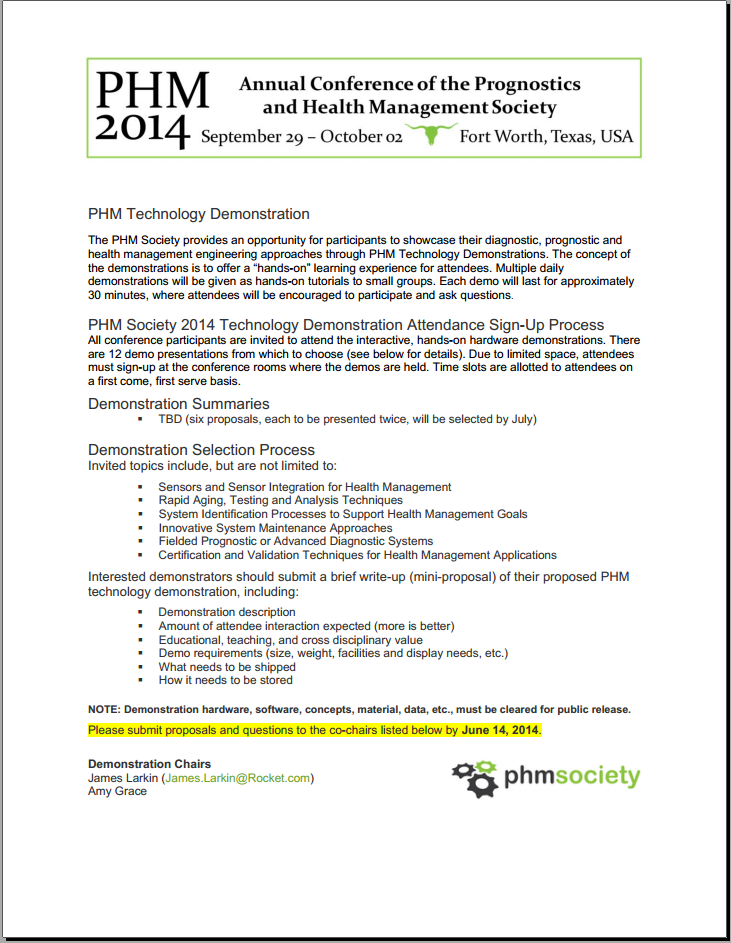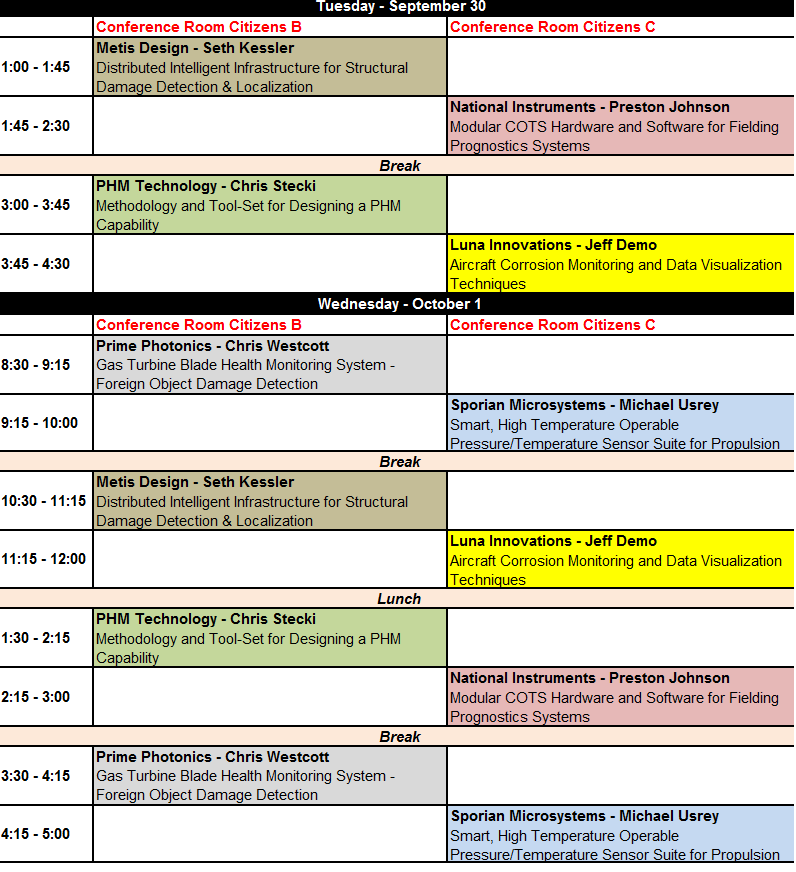PHM Technology Demonstration
 |
The PHM Society provides an opportunity for participants to showcase their diagnostic, prognostic and health management engineering approaches through PHM Technology Demonstrations. The concept of the demonstrations is to offer a “hands-on” learning experience for attendees. Multiple daily demonstrations will be given as hands-on tutorials to small groups. Each demo will last for approximately 30 minutes, where attendees will be encouraged to participate and ask questions.
Demonstration Chairs |
PHM Society 2014 Technology Demonstration Attendance Sign-Up Process
All conference participants are invited to attend the interactive, hands-on technology demonstrations. There are six different demonstrations from which to choose (see below for details). Each demonstration will be presented twice throughout the conference. Due to limited space, attendees must sign-up in advance at the demo conference rooms on the 3rd floor (Citizens B and Citizens C). Time slots are allotted to attendees on a first-come-first-serve basis on the sign-up sheet.
Technology Demonstration Topics and Presenters:
- Aircraft Corrosion Monitoring and Data Visualization Techniques
- Distributed Intelligent Infrastructure for Structural Damage Detection & Localization
- Gas Turbine Blade Health Monitoring System – Foreign Object Damage Detection
- Methodology and Tool-Set for Designing a PHM Capability
- Modular COTS Hardware and Software for Fielding Prognostics Systems
- Smart, High Temperature Operable Pressure/Temperature Sensor Suite for Propulsion and Power PHM
Demonstration Schedule

Aircraft Corrosion Monitoring and Data Visualization Techniques
Presenter: Jeff Demo, Luna Innovations Incorporated |
| This demonstration provides a comprehensive overview of the LS2A corrosion monitoring sensor nodes that have been deployed for long-term data collection on military aircraft. The system consists of a set of sensors that measure relative humidity, air and surface temperature, solution conductivity, and aluminum corrosion rate. The demonstration will focus on the process of deploying sensor nodes, activating measurements, collecting data, and analyzing the collected results.
Users will be shown how to configure the data analysis tool to provide detail on specific aspects of interest, and how to use the information presented as a tool for maintenance planning and asset tracking. Attendees of the demonstration will form small groups and work directly with sensor nodes and data interface stations, providing a hands-on, interactive learning experience. |
Distributed Intelligent Infrastructure for Structural Damage Detection & Localization
Presenter: Dr. Seth Kessler, President/CEO Metis Design Corporation |
| This demonstration will explore the use of a distributed digitization architecture coupled with a structural sonar array of PZT elements to facilitate impact and damage detection. The session will discuss the system elements, detection theory, and installation process and demonstrate live detection.
A diagnostic visualization will be displayed for impact event and loosened fasteners. Participants will have the opportunity to interact with the hardware and software. |
Gas Turbine Blade Health Monitoring System – Foreign Object Damage Detection
Presenter: Chris Westcott, Prime Photonics. |
| This demonstration will show the ability to detect and characterize Foreign Object Damage (FOD) using a gas turbine blade health monitoring system. A projectile (airsoft pellet) will be fired into an enclosed an Electric Ducted Fan (EDF), and the impacted blade will be reported by software. The impacted blade and location will be verified with a high speed camera. The presenter will provide an overview of how the results are produced.
As an additional attraction, attendees can predict which blade will be hit, and the FOCIS™ system will display the results in real time. |
Methodology and Tool-Set for Designing a PHM Capability
Presenter: Chris Stecki, PHM Technology |
| This demonstration will describe a methodology and tool-set for designing a PHM capability for a system and providing the analysis requirements to support trade-studies of how it can “buy its way onto the system”. PHM Technology (PHMT) will demonstrate the process of establishing the required diagnostic coverage for a system and the associated business case to enable Health Management of an asset. Topics will include identification of potential system failures and impact to cost and performance; identification of inherent reliability components; assessment of required diagnostic capability to cover critical failures, and generation of alternate sensor set configurations. A comparison of cost, weight, reliability, and probability of detection for the sensor set configurations will be provided.
Attendees will have the opportunity to input information to demonstrate the flexibility of the toolset. |
Modular COTS Hardware and Software for Fielding Prognostics Systems
Presenter: Preston Johnson, Principal Sales Engineer – Condition Monitoring Systems, National Instruments |
| This demonstration introduces a fleet wide condition monitoring system used in the power generation industry, NI InsightCM(tm) Enterprise. Signal processing options for feature extraction are demonstrated, along with a plug-in interface for prognostics applications. Examples of prognostic plug in applications include the IMS Center’s Watchdog Agent™, www.imscenter.net, an approach to integrated prognostics.
During the demonstration, attendees will observe the feature extraction configuration for condition indicator calculations. A baseline from an operating fan will be obtained, and deviations from normal operation will be observed. Fault signatures will be created for use by the prognostics system. A simple remaining useful life calculation will be performed along with a health radar chart indicating fault types occurring in the demonstration unit. |
Smart, High Temperature Operable Pressure/Temperature Sensor Suites for Propulsion and Power PHM
Presenter: Dr. Michael Usrey, Sporian Microsystems, Inc. |
| This demonstration will feature a smart, in situ, wide operating range, temperature/pressure sensor suite and software for display and visualization of PHM data from austere environments such as propulsion and power generation systems. Benefits of smart sensors capable of operating in harsh environments will be illustrated. As part of the demonstration, varying temperature and pressure stimulus will be introduced and the sensor polling frequency will be interactively varied.
Attendees will have the opportunity to view the stream of data that is being generated by the sensor suite, along with sensor self-identification data, mission data, life data and alarm conditions. |
